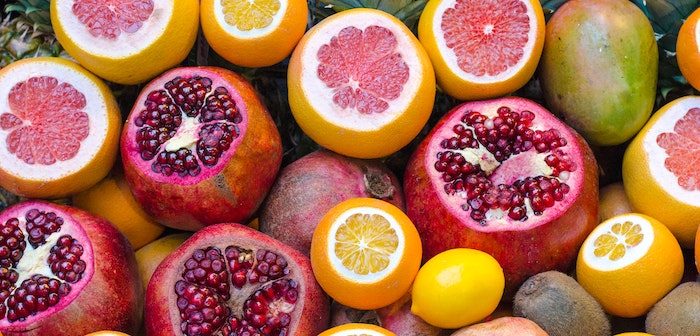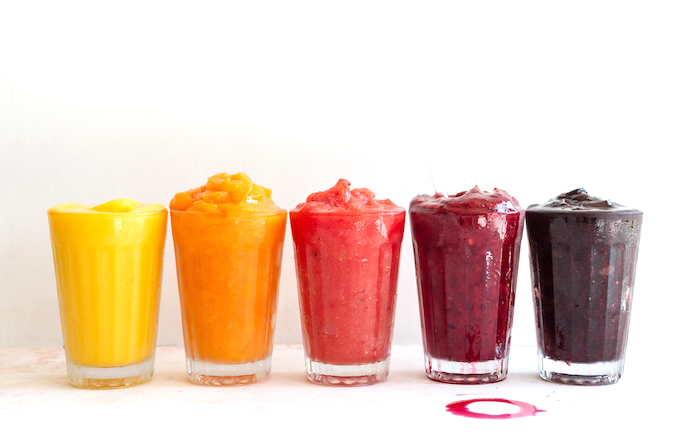What causes a non-alcoholic fatty liver to develop? This is a question that requires some clarification, as this issue now affects at least 30 % of the general population, and commonly occurs in patients with diabetes, obesity, and other metabolic risk factors (1).
Natural fructose
Let’s look at fructose in its original form: In fruits, as well as in small amounts in vegetables and nuts, fructose can always be found in combination with dietary fiber, vitamins, minerals, and other substances that are valuable to the body.
Dietary fiber delays absorption
Dietary fiber in particular plays a crucial role here: it delays the absorption of fructose into the body, and thus relieves the burden the fructose creates for the small intestine – the place where sugar is absorbed. This also relieves the liver, since that’s where the fructose is metabolized.
Freshly squeezed juice or dried fruit in moderation
If we separate the fiber from the fructose, as is the case with freshly squeezed juice, then the fructose is present in a much more concentrated form. We also see this happen in dried figs, dates, and other types of dried fruit. This creates a bigger challenge for the intestines and the liver: In this higher level of concentration, the body is absorbing the fructose much faster and in larger quantities.
Industrially produced fructose
That being said, The form of fructose that can be most harmful to our health is industrially produced fructose. And the biggest source of this is high-fructose corn syrup (HFCS).
High-fructose corn syrup is largely made from genetically modified corn or wheat starch. The glucose it contains is converted into fructose step by step by adding enzymes into it. This produces 42% to 90% HFCS. The higher the fructose content, the stronger the sweetness of the syrup. As an inexpensive sweetener, it has rapidly become a favorite ingredient of the industry and can be found on a lot of ingredient lists, under names like fructose-glucose syrup, isoglucose, or corn syrup.
Meanwhile, the syrup is “hidden” in all kinds of food industry products: In sweets, baked goods, soft drinks, but also in spreads, frozen pizza, sauces, or ready-made meals. Not everyone is aware that this sweetness is also hidden in foods that don’t even necessarily taste sweet. But at the same time, it’s understandable how the average, unaware citizen unconsciously consumes way too much hidden fructose without even realizing it.

Fructose: transformation in the body
To explain how fructose can contribute to fatty liver, it’s important to know what happens to fructose once it enters the body.
The path of fructose
- Fructose passes from food into the stomach, and from there into the small intestine.
- It gets absorbed into the bloodstream through the mucosa of the small intestine.
- Once in the bloodstream, fructose travels directly to the liver.
Note: Too much fructose can overload the small intestine so much that fructose malabsorption can happen as a result. This means that the small intestine is unable to fully absorb the fructose, which then moves on to the large intestine, causing digestive problems.
Converted to fat in the liver
Once in the liver, the fructose is converted into usable forms of energy: fatty acids and glycogen. The fatty acids are what determine a fatty liver. Some of them enter the fat depots through the blood and are stored in the legs, abdomen, or hips, for example, as an energy reserve. The rest of the fat is stored directly in the liver cells.
With moderate use of fructose combined with a healthy lifestyle, this is not problematic. The fat reserves in the liver and in the other parts of the body are used regularly and are thus always broken down. The liver remains healthy and the metabolism stays in balance.
In order to use fructose as an energy source, it first has to be converted into fat in the liver. Part of this fat is stored directly in the liver cells as an energy reserve.
Are you interessted in gaining a comprehensive understanding of the health benefits of a plant-based diet? Download the curriculum for our Holistic Nutrition Coach training program.
How does a non-alcoholic fatty liver develop?
People who consume too much fructose and other carbohydrates no longer have to use the stored liver fat as an energy source, because the body is being constantly replenished. But this means that the liver fat reserve is not only unused, but it continues to grow
Fatty degeneration of the liver
In the long term, this leads to fatty degeneration of the liver, also known as “non-alcoholic fatty liver” (2). Alcoholic fatty liver is the term used when the liver becomes fatty as a result of high alcohol consumption. The way the liver metabolizes alcohol is the same for fructose: alcohol is also converted into fat and stored in the liver.
Metabolism is now off kilter
The liver is the central metabolic organ. Its main task is to convert nutrients to make them usable for the body, and to filter out toxins from the blood. If the liver can no longer process food properly, the entire metabolism is thrown out of balance. If this vital detoxification process is disturbed, then our health will suffer some serious consequence.
If fructose and other carbohydrates are providing a constant supply of energy, the body doesn’t need to tap its energy reserves in the liver. The fatty liver that develops over time upsets the entire metabolism and ensures that the body’s vital detoxification methods no longer function.
Avoid the formation of a fatty liver
Those who consume fructose in its natural compound, i.e. in natural fruits, and who consume fruit in moderation and are conscious of the sweeteners they use, will generally not experience any problems due to fructose.
Few industrial products
The fructose that leads to the development of fatty liver is mainly what’s used in industrial products. So it’s advisable to eat as naturally as possible, and to consume industrially manufactured products sparingly. Those who occasionally partake in industrial products should always keep an eye on the list of ingredients and, in addition to the sugar content in general, should also look out for the “hidden” fructose.
Food breaks
To prevent fatty liver, it’s also important to give the body breaks from eating altogether. These short fasting periods enable the body to tap into its fat stores in the liver, thus reducing liver fat.
If you eat primarily natural foods, eat fruit and sweeteners in moderation, and give your body breaks from eating, you will prevent your body from developing a fatty liver.
Would you like to join our unique, based on nutritional sciences and practice-oriented training program for gaining a high level of health?
We are more than happy to inform you about our training program on our website!!






0 Comments